- Home
- Kathy Reichs
Bones Never Lie Page 2
Bones Never Lie Read online
Page 2
“I entered what we had, MO, signature aspects, crime scene descriptors and photos, victim details. Took weeks to get a response. Then damned if our profile didn’t match an unsolved here in Charlotte.”
“The Nance kid.” Slidell spoke through barely parted lips.
“Never got a collar on that one.” Tinker’s first words since telling Slidell he was posted locally.
Slidell opened his mouth to reply. Apparently reconsidered and closed it.
I glanced at the tub. 090431070901. Lizzie Nance. Skinny’s own gut-eating failure.
On April 17, 2009, Elizabeth Ellen “Lizzie” Nance left a ballet class, heading for her mother’s apartment three blocks away. She never made it home. Media coverage was massive. Hundreds turned out to answer tip lines, post flyers, and search the woods and ponds near Lizzie’s complex. To no avail.
Two weeks after Lizzie’s disappearance, a decomposed body was found at a nature preserve northwest of Charlotte. The corpse lay supine with feet together, arms tucked to its sides. A black leotard, tights, and pink cotton underwear still wrapped the putrefied flesh. Bright blue Crocs still covered the feet. Residue found under a thumbnail was identified later as common facial tissue.
Slidell led the homicide investigation. I analyzed the bones.
Though I spent days bending over a scope, I spotted not a single nick, cut, or fracture anywhere on the skeleton. Tim Larabee, the Mecklenburg County medical examiner, was unable to establish definitively whether sexual assault had occurred. Manner of death went down as homicide, cause as unknown.
Lizzie Nance died when she was eleven years old.
“Fortunately, Honor had also entered his unsolved. The system picked up the similarities.” Rodas raised both hands. “So here I am.”
A moment of silence filled the room. Tinker broke it. “That’s it? Two girls roughly the same age? Still wearing their clothes?”
No one responded.
“Wasn’t the Nance kid too far gone to exclude rape?”
Palming the table, Slidell leaned toward Tinker. I cut him off.
“The autopsy report noted complicating factors. But the child’s clothing was in place, and Dr. Larabee was confident in concluding there’d been no rape.”
Tinker shrugged, not realizing or not caring that his cavalier attitude was offending everyone. “Seems weak.”
“It’s not just the VICAP profile that brings me to Charlotte,” Rodas continued. “By the time we found Nellie, her body had been rained on for a day and a half. Her clothes were saturated with a mixture of water and decomp runoff. Though not optimistic, I submitted everything to our forensics lab up in Waterbury for testing. To my surprise, some DNA had survived.”
“All hers,” Slidell guessed.
“Yes.” Rodas placed his forearms on the table and leaned in. “Eighteen months ago, I went over the file yet again. This time I caught something I thought could be a break. The residue from Nellie’s hand hadn’t been submitted with her clothing. I phoned the ME; she found the scrapings taken at autopsy by her predecessor. Knowing it was a long shot, I had her send them up to Waterbury.”
Rodas looked straight at me.
I looked straight back.
“The material contained DNA not belonging to Nellie.”
“You sent the profile through the system?” Tinker asked the unnecessary question.
Rodas chin-cocked the report in my hands. “Take a look at the section marked ‘Updated DNA Results,’ Dr. Brennan.”
Curious why I’d been singled out, I did as instructed.
Read a name.
Felt the flutter of adrenaline hitting my gut.
CHAPTER 2
THE REPORT WAS short, printed in both French and English.
Struggling to make sense of it, I reread the closing paragraph. In both languages.
A match was obtained on DNA sample 7426 to Canadian national number 64899, identified as Anique Pomerleau, W/F, DOB: 12/10/75. The subject is currently not in custody.
Anique Pomerleau.
My eyes rose to Rodas. His were still fixed on me. “You can imagine how amped I was. Years of nothing, then I get word they’ve sequenced DNA that isn’t Nellie’s. I told the analyst to shoot the profile through CODIS.”
Like VICAP, the Combined DNA Index System is a database maintained by the FBI. CODIS stores DNA profiles and uses two indexes to generate investigative leads.
The convicted offender index contains profiles of individuals convicted of crimes ranging from misdemeanors to sexual assault and murder. The forensic index contains profiles obtained from crime scene evidence, such as semen, saliva, or blood. When a detective or analyst enters an unknown profile, the CODIS software electronically searches both indexes for a potential match.
A match within the forensic index links crimes to one another, possibly identifying serial offenders. Based on a “forensic hit,” police in multiple jurisdictions can coordinate their investigations and share leads. A match between the forensic index and the convicted offender index provides investigators with an “offender hit.” A suspect. A name.
Anique Pomerleau.
“She’s not American.” Lame, but that’s what I said. What I meant was, how did Rodas get a match to a Canadian citizen? Our neighbors above the forty-ninth use the CODIS software but maintain their own national repository of DNA data.
“We came up blank in the U.S., so I decided to send the profile north. It’s not uncommon. Hardwick is less than an hour’s drive from the border.” Rodas pointed at the report I was holding. “That’s from the Canadian National DNA Data Bank.”
I knew that. In the course of my work at the Laboratoire de sciences judiciaires et de médicine legale in Montreal, I’d seen dozens of these reports. The pseudoephedrine and oxymetazoline I’d taken for my cold were short-circuiting my ability to articulate clearly. “How did you make the connection to me?” I clarified.
“The hit was in Canada, so it seemed logical to start there. I have a buddy at the Royal Canadian Mounted Police. He ran the name and found an Anique Pomerleau who fit the identifiers. Pomerleau is wanted by the Sûreté du Québec on a warrant dating to 2004.”
“Hold on. You’re saying that five years after the Canadians are looking for this chick, she leaves DNA on a dead kid in Vermont?” Tinker, king of compassion.
“The lead detective still works there, but apparently, he went AWOL recently.” Rodas gave a wry smile. “I got the feeling that was a story in itself.”
I felt a soft pulsing in my wrist. Stared at the delicate blue vein worming under my skin.
“No one remembered much about the perp or the case. But a coroner hooked me up with a pathologist who’s been around forever. Pierre LaManche.
“LaManche told me Pomerleau was a suspect in the deaths of several young girls. Said her accomplice was a guy named Neal Wesley Catts. Back in ’04, Catts either shot himself or Pomerleau killed him. Then she vanished.
“I told LaManche about the DNA found on Nellie Gower’s hand and about the VICAP match to your unsolved here in Charlotte. He advised me to contact Dr. Brennan.”
Anique Pomerleau.
The monster.
The only one who ever got away.
I kept my face blank. My eyes focused on the vessel snaking my flesh.
“You’re thinking Pomerleau did both Gower and the Nance kid.” Tinker, again stating the obvious.
“I think it’s a possibility.”
“Where’s she been all this time?”
“We sent out a BOLO.” Be on the lookout. “So did the SQ, though I didn’t feel a lot of love there. Can’t really blame them. It’s been ten years. Pomerleau’s maybe dead, maybe using an alias, and the only pic they have dates to 1989.”
I remembered. It was the only photo we had. Taken when Pomerleau was around fifteen.
“So. After Montreal, Pomerleau goes to ground for three years, then resurfaces and grabs a kid in Vermont.” From his tone, I knew Slidell was rolling the
theory past his own ears.
“Last I checked, North Carolina’s a few miles from the tundra,” Tinker said. “How’d Pomerleau end up here?” When no one responded, he pressed on. “DNA links this Pomerleau to the Gower kid. But what links Gower to Nance? I said it before, and I’ll say it again. It’s sad, but kids are murdered every day. What makes you so sure we’re looking at one doer?”
The pressure in my sinuses suddenly felt explosive. Discreetly, I pressed a hand to one cheek. My skin was fiery hot. Was the virus upping the ante? Or was it the shock of what I was hearing?
As I reached for a tissue to blow my nose, Rodas ticked off points, beginning with his right thumb. “Both victims were female. Both were eleven to fourteen years of age. Both vanished during daylight from a public road—a highway, a city street. Both were left on the surface in an unprotected setting—a quarry, a field. Both bodies were lying faceup, with arms and legs straight, hair carefully arranged.”
“Posed,” Barrow said.
“Definitely.”
Rodas shifted to his left hand. “Both victims were clothed. Both had remnants of tissue on their fingers. Neither showed evidence of trauma. Neither showed evidence of sexual assault.” He withdrew a plastic sleeve from his carton and put it on the table. Inside was a white-bordered five-by-seven color print.
Barrow dug a similar print from the tub and placed it beside Rodas’s. As one, we leaned forward to view them.
The photos were undoubtedly school portraits. The kind we all sat for as kids. The kind kids still take home every year. The backgrounds differed. A tree trunk versus rippled red velvet. But each subject looked straight at the camera with the same awkward smile.
“I got to admit,” Tinker admitted, “they are of a type.”
“Of a type?” Slidell pooched air through his lips. “They look like friggin’ clones.”
“Both victims were roughly the same height and weight,” Rodas said. “No bangs. No glasses. No braces, which I’d guess are fairly common in that age group.”
It was true. Both girls had fair skin, fine features, and long dark hair center-parted and drawn back from the face. Gower had hers tucked behind her ears.
I looked at Lizzie Nance. At the face I’d studied a thousand times. Noted the dusting of caramel freckles. The red plastic bow at the end of each braid. The hint of mischief in the wide green eyes.
And felt the same sorrow. The same frustration. But new emotions were stirring the mix.
Unbidden, images genied up in my mind. An emaciated body curled fetal on a makeshift bench. Yellow-orange flames dancing on a wall. Blood-spattered crystal casting slow-turning shadows across a dimly lit parlor.
My gaze drifted past Slidell toward the back of the room.
Though I couldn’t see the view from where I was seated, I knew the window looked out over the parking lot. And the buildings of uptown. And the interstate snaking through the power grids of the Northeast. And the far distant Canadian border. And a dead-end street beside an abandoned railroad yard. Rue de Sébastopol.
The sound of silence brought me back to the present.
“You need a break?” Barrow was studying me with an odd expression. They all were.
I nodded, rose quickly, and left the room.
As I hurried up the hall, more images popped. A dog collar circling a willowy neck. Dark refugee eyes, round and terrified in a morgue-white face.
I locked the lavatory door, crossed to the sink, and held my hands under the faucet. Watched and didn’t watch as water ran over them. A full minute.
Then I cupped my fingers and drank.
Finally, I straightened and looked in the mirror. A woman looked back, knuckles white as the porcelain she was clutching.
I studied the face. Not young, not old. Hair ash blond but showing gray feelers. Eyes emerald green. Revealing what? Grief? Rage? Congestion and fever?
“Pull yourself together.” The reflected lips mouthed the words. “Do your job. Nail the bitch.”
I shut off the tap. Yanked paper towels from the dispenser and dried my face. Blew my nose.
Returned to the CCU squad room.
“—just saying it’s unusual to find no sexual component.” Tinker sounded steamed.
I resumed my seat.
“Who knows what’s sexual to these fuckwads.” Slidell slumped back in his chair, dragging a balled fist across the tabletop.
“If the perp’s female, we could be looking at a whole different ball game,” Tinker said.
“Yeah, well, it’s our ball game,” Slidell snapped. After a pause, “Gower was 2007.”
“So?”
Slidell slid Tinker a withering look. “Gower was 2007. So there’s a three-year gap between Vermont and what went down earlier in Montreal. Another year and a half goes by and Nance is grabbed here.”
“What’s your point?”
“Time line, you dumb shit.” Slidell shot to his feet before Tinker could fire off a cutting retort. “I’m done here.”
“Let’s call it a morning.” Barrow, trying to defuse what was escalating toward open combat. “We’ll reconvene when Detective Slidell and the doc have reviewed the Nance file.”
A look passed between Barrow and Slidell. Then Skinny was gone.
“Send in the clowns.” Giving a tight shake of his head, Tinker pushed up from his chair.
Rodas watched Tinker disappear through the door before eyebrowing a question at Barrow. Barrow gestured at him to stay put. Rodas settled back. So did I.
Slidell reappeared minutes later, a manila folder in one hand. Attached to the folder was a snapshot.
Dropping into the closest chair, Slidell thumbed off the paper clip and placed the photo beside the two school portraits.
I felt adrenaline flutter anew.
The girl had brown eyes and light olive skin. Her long chestnut hair was center-parted and drawn up in combs. I guessed her age at twelve to thirteen.
“Michelle Leal. Goes by Shelly,” Slidell said. “Thirteen. Lives with her parents and two siblings in Plaza-Midwood. Last Friday afternoon the mother sent her to a convenience store at Central and Morningside. She bought milk and M&M’s around four-fifteen. Never made it home.”
I’d spent most of the weekend zoned out on cold meds, drifting off quickly every time I turned on the TV. I recalled vague fragments of news reports on a missing child, video of a search team, a mother’s teary appeal.
Now I was seeing that little girl’s face.
“She hasn’t turned up?” I swallowed.
“No,” Slidell said.
“You think it’s related.”
“Look at her. And the MO fits.”
I glanced up. Met Barrow’s eyes. “You think I’m the draw,” I said evenly.
Barrow tried a comforting smile. It didn’t work out.
“You think Pomerleau learned where I live, came here, and killed Lizzie Nance. And now she’s taken Shelly Leal.”
“We have to consider the possibility,” Barrow said quietly.
“That’s why you asked me here this morning.”
“That’s one reason.” Barrow paused. “With cold cases, we’ve got all the time in the world. No pressure from the public, the media, the guys up the pay scale. That won’t be the situation with Shelly Leal.”
I nodded.
“Maybe the kid’s already dead,” Slidell said. “Maybe not. Gower was found eight days after she was snatched. If Leal is alive, we may be looking at a real narrow window.”
Barrow jumped back in. “You’re familiar with Pomerleau’s thinking, her way of operating.”
“I’m an anthropologist, not a psychologist.”
Barrow raised both palms. “Understood. But you were there. That’s one reason we need your help.”
“And the other?”
“A detective named Andrew Ryan was lead on the Pomerleau investigation. Word is you know the guy personally.”
Heat rushed my face. I hadn’t seen that one coming.
&
nbsp; “We want you to find him.”
CHAPTER 3
“I DO NOT keep track of Detective Ryan’s whereabouts.”
My heart was still sending blood to my cheeks. I hated it. Hated that I was so easy to read.
Barrow had a habit of clearing his throat. He did it now. “You’ve worked with this Ryan a long time, right?”
I nodded.
“Do you know why he dropped off the grid?”
“His daughter died.”
“Suddenly?”
“Yes.” OD’d in a heroin den.
“Age?”
“Twenty.”
“That would knock anyone off the rails.”
I glanced down at my watch. Reflex. I knew the time.
“It’s been almost two months, and no one has a clue where this Ryan has gone.”
I said nothing.
“He ever talk about favorite getaways? Places he wanted to visit? Places he’d gone on vacation?”
“Ryan is not the vacationing type.”
“The guy has quite a reputation.” Rodas grinned. “Way they parlez-vous up there, he’s cleared every homicide since the Black Dahlia.”
“Elizabeth Short was killed in L.A.”
The burn of embarrassment also colored Rodas’s cheeks. Or something did.
“Ryan worked Pomerleau,” Barrow said. “We could really use his input.”
“Good luck.” Testy, but I don’t respond well to pressure.
“LaManche had the impression that you and Ryan were close.”
I managed to curb my impulse to get up and leave.
“Sorry. That came out wrong.”
No, Detective Rodas, that came out right. Ryan and I share more than murder. We share memories, affection. We once shared a bed.
“What I meant was, LaManche thought if anyone could find Ryan, it would be you.”

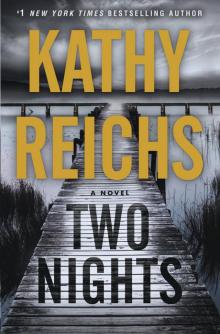 Two Nights
Two Nights The Bone Collection: Four Novellas
The Bone Collection: Four Novellas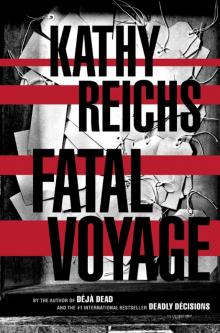 Fatal Voyage
Fatal Voyage 206 Bones
206 Bones Bones to Ashes
Bones to Ashes Terminal
Terminal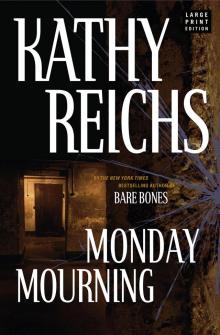 Monday Mourning
Monday Mourning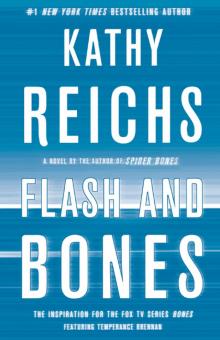 Flash and Bones
Flash and Bones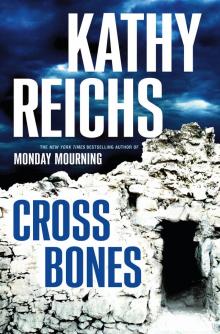 Cross Bones
Cross Bones Devil Bones
Devil Bones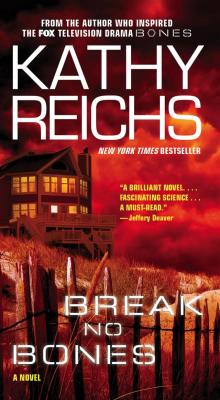 Break No Bones
Break No Bones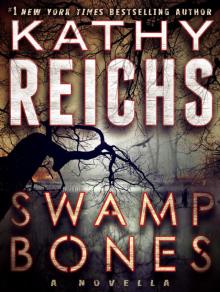 Swamp Bones
Swamp Bones Déjà Dead
Déjà Dead Shock
Shock Spider Bones
Spider Bones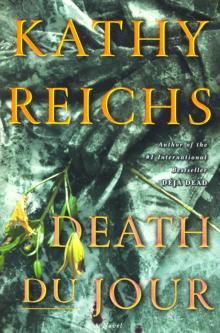 Death Du Jour
Death Du Jour Grave Secrets
Grave Secrets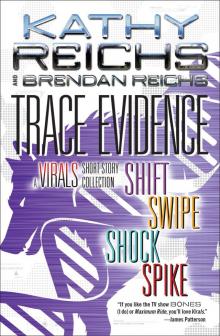 Trace Evidence: A Virals Short Story Collection
Trace Evidence: A Virals Short Story Collection Bones on Ice
Bones on Ice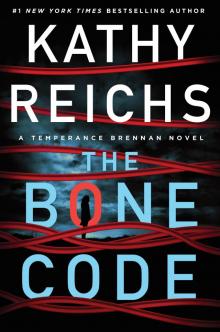 The Bone Code
The Bone Code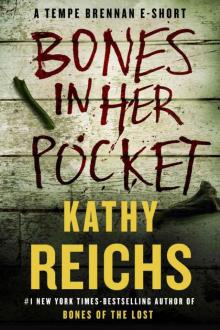 Bones in Her Pocket
Bones in Her Pocket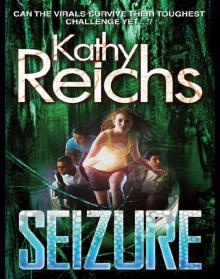 Seizure:
Seizure: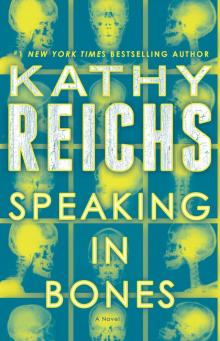 Speaking in Bones
Speaking in Bones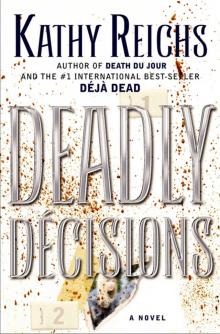 Deadly Decisions
Deadly Decisions Spike
Spike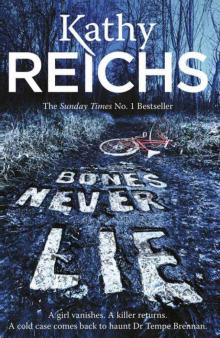 Bones Never Lie
Bones Never Lie Bones of the Lost
Bones of the Lost Virals 03.5 - Swipe
Virals 03.5 - Swipe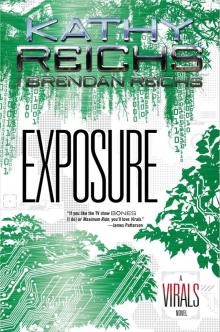 Exposure
Exposure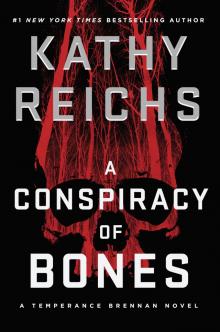 A Conspiracy of Bones
A Conspiracy of Bones Shift (tory brennan)
Shift (tory brennan) Bones of the Lost: A Temperance Brennan Novel tb-16
Bones of the Lost: A Temperance Brennan Novel tb-16 Virals tb-1
Virals tb-1 Bones Are Forever tb-15
Bones Are Forever tb-15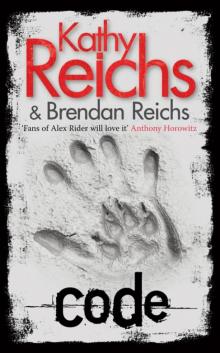 Code tb-3
Code tb-3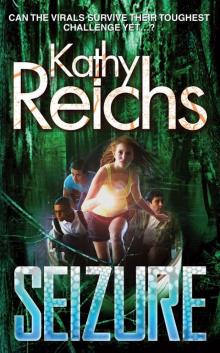 Seizure tb-2
Seizure tb-2 Deadly Descisions
Deadly Descisions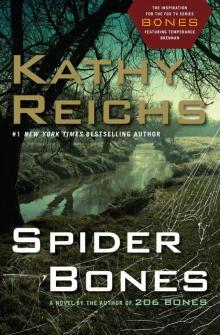 Spider Bones: A Novel
Spider Bones: A Novel